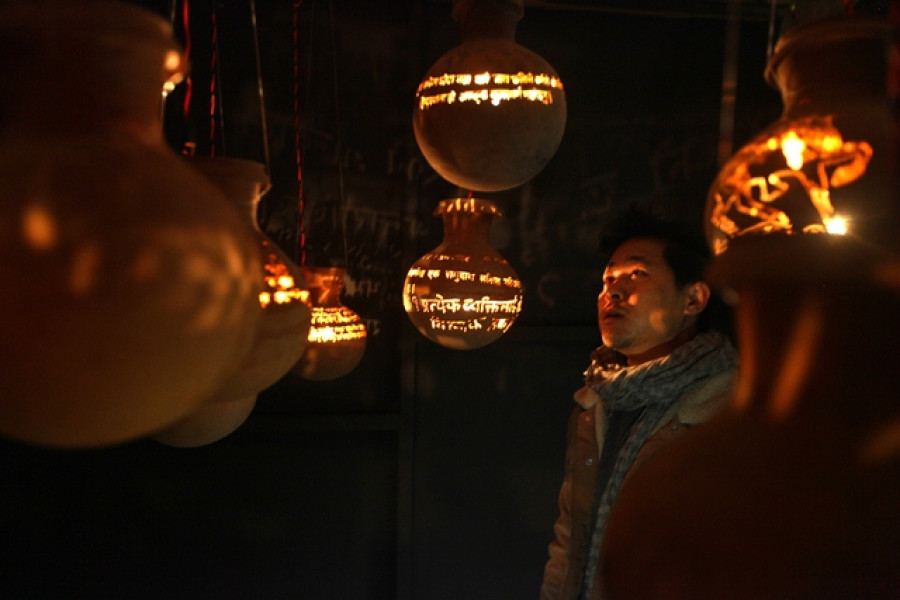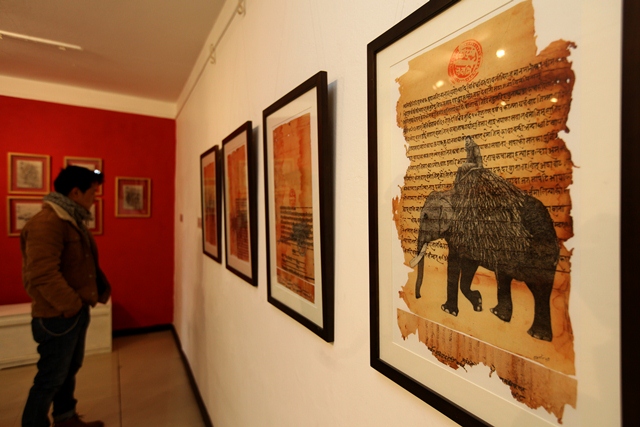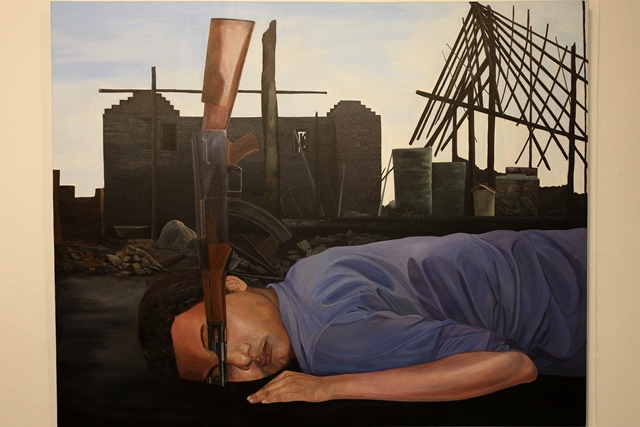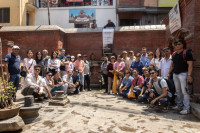Culture & Lifestyle
Art that speaks of an indigenous community’s historical subservience
Artist Lavkant Chaudhary’s latest exhibition ‘Masinya Dastoor’ brings forward the silenced narratives of Tharu community.
Srizu Bajracharya
It’s a cold rainy day, and at Siddhartha Art Gallery, Lavkant Chaudhary’s exhibition ‘Masinya Dastoor’ makes you feel even colder. His artworks pull a narrative of ineffable lost grief of Tharu community.
One of the first painting, which is also an introduction to the depth of the experience that Chaudhary wants to bring to the forefront, shows a man spraying Dichloro Diphenyl Trichloroethane (DDT), an insecticide, to a dense forest area. The acrylic painting also shows people as minute beings, in the size of mosquitoes as though to connote their lives as insignificant. While the dominant dark mustard backdrop of the canvas feels like a gloomy sunset with no shades of bright hues. The rendition perhaps intends to make the spectators feel the suffocation Tharu community went through in the 50s. But the thick feeling that holds you at that moment follows you through the rest of the exhibition.
The description of the series reads, ‘During the 50s and 60s, with support from the United States of America and the WHO, the Nepali government led a campaign to eradicate malaria off the Tarai region.’ But the same eradication also subjugated the lives of Tharu people. And this is the premise of Chaudhary’s artworks in mix media, it takes viewers on a journey to understand the repressed history of Tharus.
It is said that history is written by people in power, and therefore many a time, the stories we are exposed to are often argued as narratives that expend the views of minorities. In a diverse country like Nepal, that may be true as the history we know dominates the indigenous narratives. And what we don’t know of those stories are yet to be documented.

But at Siddhartha Art Gallery, as an artist, Chaudhary uses his creativity to transport spectators to the Tarai region and back in time, introducing them to the adversities of the Tharu community.
In the Muluki Ain 1854, the Tharus were one of the indigenous groups categorised as ‘paani chalne masinya matwali’, a touchable enslavable alcohol-drinking group, which lawfully made them an expendable population. And in the years that followed, many Tharu people were displaced from their own homes and lands.
This is what Chaudhary exhibits dexterously in his ‘Tamasuk series’. He paints the picture of slavery Tharu people were subjected to during Shah and Rana regime. Their lands were distributed and rewarded to royal administrators and bureaucrats. And in these letters, he makes stippling drawings of the lives that describe Tharu people—of a lean Tharu man carrying harvested crop in baskets; of oxen tilling fields; of a hansuli, a piece of traditional Tharu jewellery. Some of them also show expression of misery, like that of an old woman, who sits on the ground with both her hands on her head, portraying her helpless pain.
The characters in the stippling drawings are quite common in Nepali art, but what makes Chaudhary’s characters stand out is how he places them in his storytelling. The Nepali lokta paper he uses as canvas resembles the texture of a crumpled paper, like lost and found documents that were somewhere and somehow salvaged by someone, and have aged with time.
These papers in itself imbue a dull poignant colour to the story that he is trying to tell. Chaudhary’s work, which is part of The Himalayan Light Art Scholarship, makes you believe in the grim experience of Tharu people with the unclean textures he recreates.

At the right corner of the hall, Chaudhary hangs about twenty-five small wooden boxes, which hold in them cereals and grains, and has a bullet sticking out of each of the boxes. The artist gives intricate details to all of the bullets, with some boxes only holding on to the bullet shells. The installation is Chaudhary’s attempt at offering a glimpse to the kamaiya and kamlari (indentured girl child labour) system the community was subjected to during the time.
In another artwork series titled ‘The Diary: Barefaced Truth of the Suppressed, 2019’, Chaudhary recreates the diary of Jokhan Ratgainya, a Tharu journalist who was murdered on June 2001 by the then Royal Nepal Army during the civil war. He uses wood to resemble pages of the diary and carves Ratgainya’s poems and articles about Tharu movements.
The attempt feels as though Chaudhary wants viewers to understand the struggles of the community to ensure equal rights against discrimination. The visuals are as sharp and piercing like the penetration of his pen to paper, like that of his scrapings when it carves deep indelible patterns to an object. The woodwork series feels like forsaken ageing marks on doors. And perhaps that is what Chaudhary wants people to feel, the experience of a person’s endeavour to document experiences to make it indelible. But yet with time, everything will wane—the carvings too will someday fade, despite the artist’s attempt to hold on to it.
Chaudhary uses art as political expression and thereby makes it staggeringly poignant. He doesn’t try hard to portray beauty in his works, rather his artworks show the time he has taken to understand the history of Tharu culture and their movement. It seems as though with these narratives, the artist has been reliving these stories.
‘Masinya Dastoor’ is not just an artwork installation, it is an experience. Even if you are not an art lover, this exhibition will speak to you because Chaudhary breaks the conventional beauty of art and goes deeper into making it influential and evocative. As the year comes to a close end, Chaudhary’s artworks also speak for the kind of art Nepal needs, art that isn’t just rendering beauty but telling important stories. Art that is critical and urge you to address socio-cultural issues.
The exhibition will be on display until January 9, 2020 at Siddhartha Art Gallery, Baber Mahal Revisited.




 13.98°C Kathmandu
13.98°C Kathmandu















